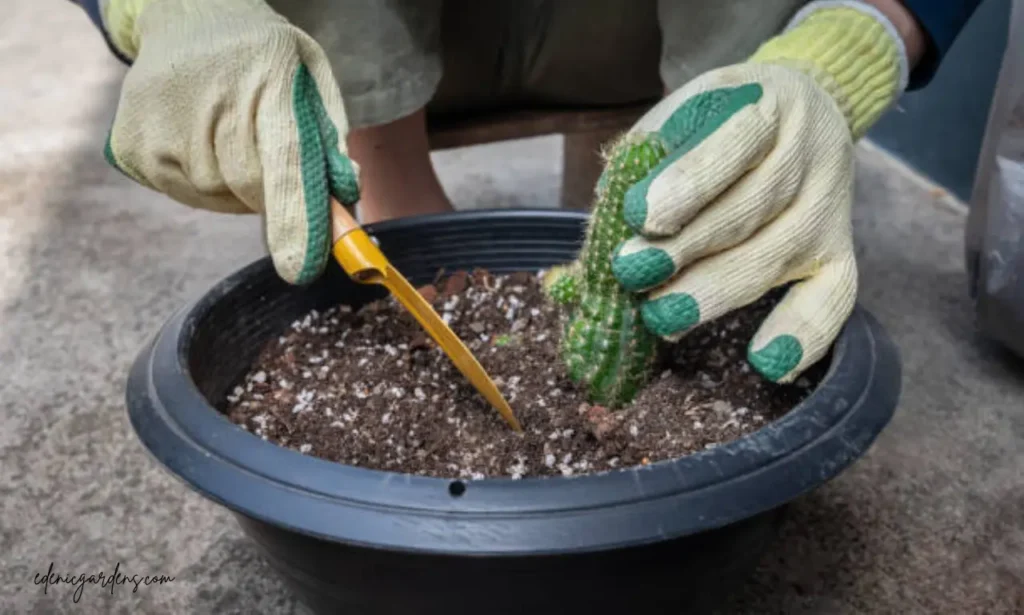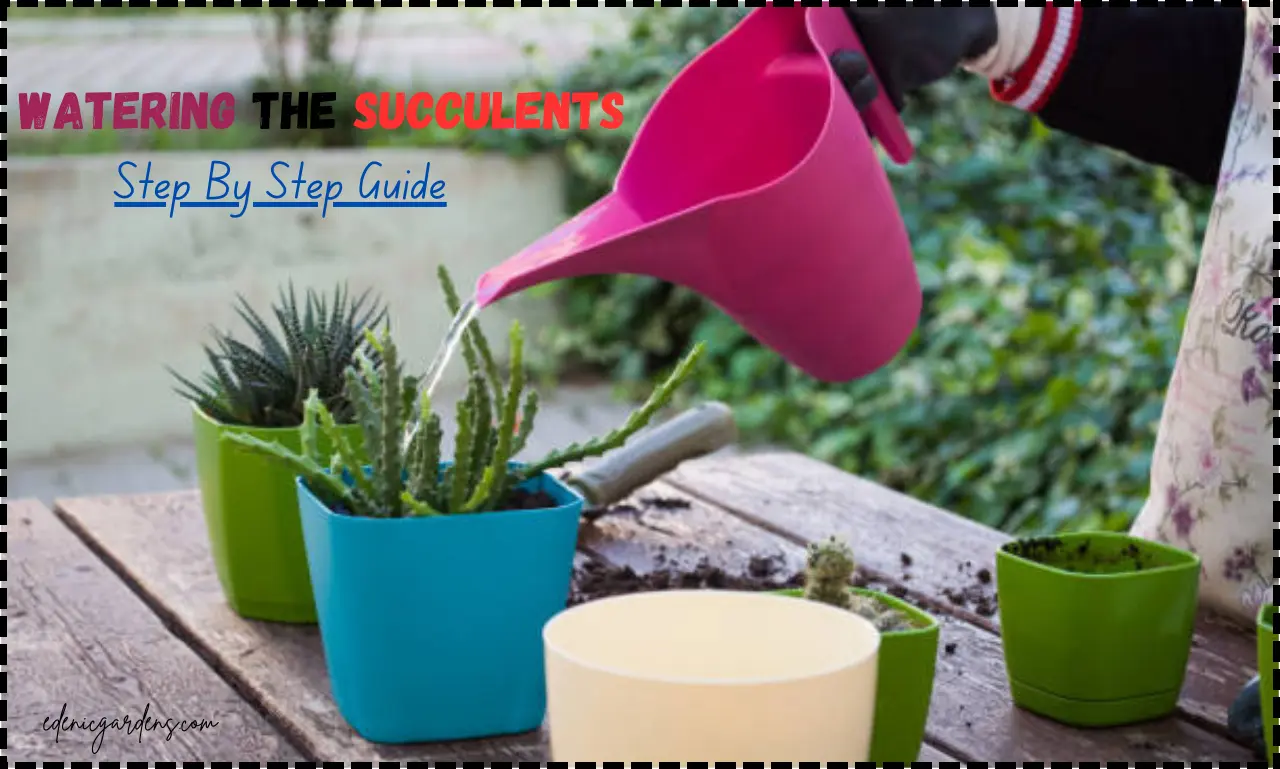In this step-by-step guide, I’ll share my journey and simple tips for watering the succulents effectively. By understanding their unique needs to recognizing the signs that they’re thirsty, you’ll learn everything you need to keep your succulent garden thriving. This guide will help to demystify the process and ensure your leafy friends flourish with vibrant health. So grab your watering can, and let’s dive into the world of succulent care together; let’s Start The Journey!
How to Water Succulent Plants
Watering succulent plants can be simple if you understand their needs. The key to maintaining happy succulents lies in the “soak and dry” method. Instead of frequent watering, give your plants a thorough soak, ensuring water reaches the roots.
- When choosing pots for your succulentt, drainage holes are crucial. They allow excess water to escape from Roots.
- Containers made from ceramic material or terra-cottaa.
These Container provide aesthetic appeal and also help to regulate moisture levels by allowing some evaporation through their porous surfacess. Don’t shy away from getting your hands a little dirty; regularly check the soil’s dryness before watering again to ensure you’re respecting those hardy little beautiess’ thirst.

How Often Should Succulents Be Watered?
These Succulent plants thrive on infrequent watering, so keeping an eye on their moisture level. A great trick is to use a moisture meter, lets you know exactly when your plant needs a drink and helps to prevent over-watering.
Gave them a good soak until water drains out of the bottom of the pot. This encourages their roots to grow deeper in search of moisture. Remember these factors affect, how often you’ll need to hydrate your succulent from temperature and humidity levels to the size of its pot and type of soil. If the leaves begin looking dried out, that’s a signal it’s thirsty!
These are several factors that influence how often your succulent needs for watered.
1. Temperature
The frequency of watering your succulents largely depends on the temperature they are exposed to.
- When temperature is hot and sunny, these hardy plants will need more water. In warm weather, their leaves may lose moisture quickly due to evaporation and transpiration.
- On cooler days or during winter months, succulents enter a resting phase and require much less water. You might find that watering them once every few weeks is sufficient.
2. Humidity
The frequency of watering succulents can greatly depend on the humidity levels in your environment.
In a dry climate, these hardy plants may need water more often, while high humidity can lead to over-watering. If the air is more humid, you need to water your succulents once every two to three weeks. Pay attention to the leaves of your succulents as well.
- When they start looking plump and firm, it’s a good sign that they’re happy with their moisture level.
- If they appear shriveled or wrinkled, it could signal that it’s time for a drink—regardless of humidity.
Adjust your watering schedule based on season changes and indoor humidity patterns for thriving greenery all year round.
3. Sunlight
These hardy plants thrive in bright light, which helps them store energy and maintain their vibrant colors. Succulents should be watered every 1 to 3 weeks, depending on the season and your local environment. During hot summer months with long sunlight hours, your plants need a little more water, while in cooler months, they can go longer between drinks.
4. Season
Watering the succulents depends on the season, as their needs change with the weather.
- In spring and summer, when temperatures rise, and the sunlight is full, your succulent will be in the active growth phase. During this time, it’s a good idea to water them more frequently about every 1-2 weeks.
- In Winter, most succulents need far less water sometimes only once a month or even less. This shift not only helps them to conserve energy but also prevents over-watering during their rest period.
Remember that factors like humidity and indoor heating can also affect their moisture needs. Always trust your instincts by observing how your plants respond to their environment.
How to Prevent Overwatering
When caring for succulent houseplants, one of the most common problems is over watering.
- Always choose pots with drainage holes. These little openings allow excess water to escape.
- Succulents thrive in well-draining soil that mimics their native environments.
- succulents can be a game-changer, so an indoor potting mix is designed specifically.
- check the moisture level before watering.
- Create a watering schedule based on the seasons since succulents require less water during dormancy or in colder months.
Finally, be mindful of where you place your plants—too much humidity or shade can trick you into thinking they need more water than they actually do. By following these simple steps, you’ll ensure your beautiful succulents stay healthy and vibrant.
Signs Your Succulents Need Water
When your succulent leaves looking wrinkled or shriveled, it’s a clear signal that your plant is thirsty. This happens when they’re not getting enough water to stay plump and healthy. When the leaves lose their firmness, it’s like a cry for help.
Another sign to watch for is color changes. Healthy succulents often display vibrant hues, but when they start turning brown or dull, it could mean they’re dehydrated. If the soil feels dry all the way down especially if it pulls away from the pot—it’s time for a good drink.
- Wrinkled leaves: Wrinkled leaves is one of the most telling sign that your succulent to need water.
- Bendy leaves: If you’ve noticed your succulent’s leaves looking a bit bendy, it’s time to pay attention to watered them.
- Crispy leaves: If your succulent’s leaves are looking crispy, it’s a clear sign they’re thirsty.
- Shrinking: One of the most telling signs your succulents need water is shrinking leaves
Conclusion
In conclusion, watering to succulents is crucial for their health and vitality. By following the step-by-step tips outlined in this article, you can ensure that your plants receive the right amount of moisture without the risk of over-watering. Remember to consider factors such as pot type, climate, and season when determining your watering schedule. Now that you’re equipped with these essential watering techniques and give your succulents the care they deserve for a thriving indoor garden.
FAQ’S
1. How often should I water my succulents?
Water your succulents every 2-3 weeks, allowing the soil to dry out completely between waterings.
2. What type of water is best for succulents?
Room temperature tap water or rainwater is ideal. Avoid distilled or softened water as they can harm the plants and plant growth.
3. Should I mist my succulents?
No, misting is not recommended for succulents; it can lead to rot. Instead, soak the soil thoroughly and let it dry out

